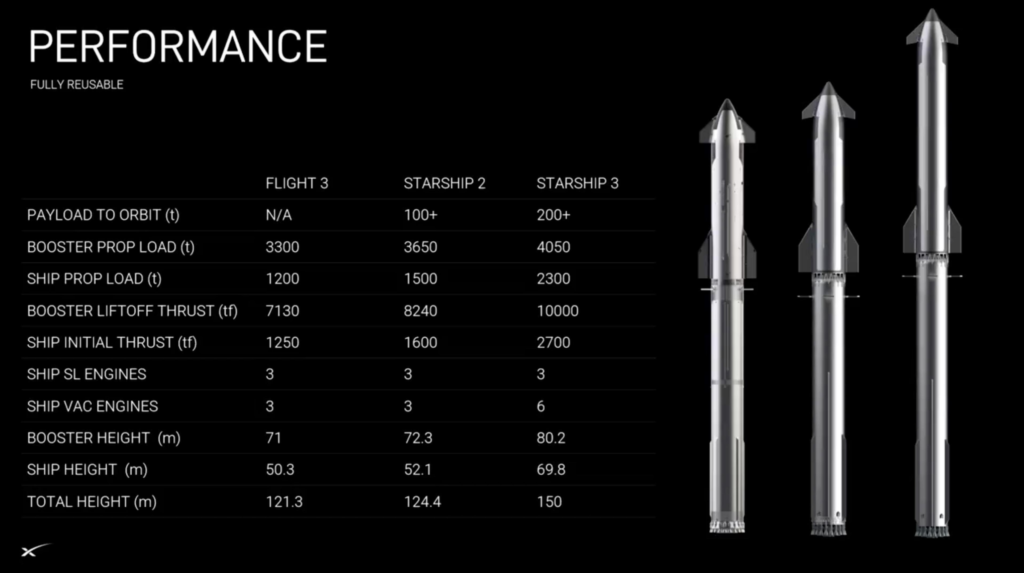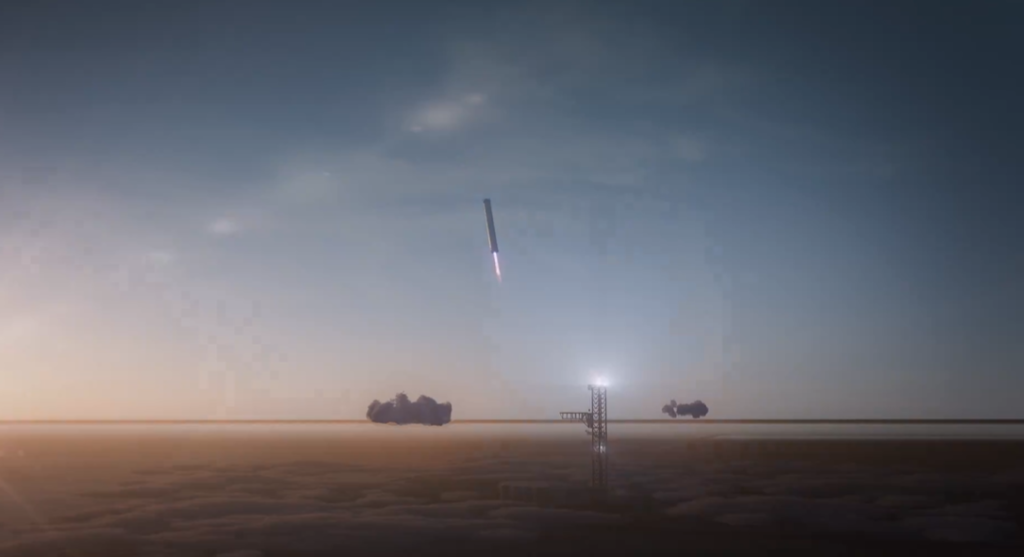As SpaceX prepares for flight 4 of Starship, they are also busy designing and planning additional vehicle variants that are even larger than the current rocket. While in the past few months, we received a few updates and hints from the company, a new update from Musk provided some specific measurements and insights into Starship V3. This included specific heights for both the booster and upper stage, additional Raptor engines, and propellant needs, just to name a few.
Not only that, but they are also hinting at plans to catch the booster with the launch tower chopsticks as soon as a few more test flights. Here I will go more in-depth into the new update, Starship’s upgraded variant, upcoming plans, and more.
Starship V3 Update

Just a few days ago on the 4th, Elon and SpaceX hosted an update on Starship at Starbase. Here he went over a bunch of information including details about Starship’s upgraded variant. Provided during the presentation was a graphic highlighting some of the major changes to Starship V3. Here you can see both a visual representation and actual numbers for the Flight 3 Starship which just launched, and Starship 2 and 3. Focusing on Starship 2 first you can see its a bit taller than the current prototypes with an extra 2m of ship height and 3m of booster height. It also has a bit of an increase in prop load and liftoff thrust providing it with a payload capacity of over 100 tons.
Looking at Starship 3 however, is where some really significant upgrades come into play. For one the ship is much taller and looks like a stretched-out version of the current vehicle. Obviously, this is just an initial graphic but there are some details that we could end up seeing in the future. The interstage seems to be even bigger with a larger distance between the hot stage ring and the grid fins. The ship itself also looks like its receiving the majority of the size with a ship height of 69.8m and a booster height of 80.2. At that size, the two stages are almost the same. The fins also look to be a bit larger. Focusing more on the data we can see an additional 3 Vacumm Raptor engines will be added to the upper stage of V3. This in combination with a steep increase in propellant volume is hoping to support a payload capacity of over 200 tons.
At this new size, which comes out to 150m tall, Starship would be taller than the current launch tower in Boca Chica. Not only that but additional infrastructure upgrades to support even more mass and power will likely be needed. While exciting, SpaceX still has a decent amount of work left before we start to these upgraded variants launching for the first time. During the presentation, Musk mentioned that the recent flight 3 was capable of launching roughly 40 to 50 metric tons of payload to LEO. That makes the difference between the current vehicles and Starship 2 more significant.
Right now, SpaceX has a few V1 Starship prototypes nearly ready for flight attempts. Based on a few factors like upcoming test flights, how they turn out, and the upgrade timeline will all determine how long before they move to the next stage. SpaceX will likely want to prioritize its constructed prototypes and also reach orbit and return successfully first. At that point, they can start experimenting with much more powerful variants and design plans.
Besides the specs of these future Starships, they also talked about the cost which is just as impressive. They are still targeting an eventual reusable V3 flight at around $2 million per launch. To put that in perspective a launch at 2 million is much cheaper than a Falcon 9 flight which is currently launching more than any other rocket.
Starship Flight 4

Besides information on Starship’s future variants, we also got some hints about the future Booster catch attempts and Flight 4. For example, yesterday the company tweeted saying, “The update included near-term priorities for Starship that will unlock its ability to be fully and rapidly reusable, the core enabler for transforming humanity’s ability to send large amounts of payload to orbit and beyond.” With this was a new animation of the booster catch attempt. Here you could see the booster flying toward the tower, starting its landing burn using the inner engines, and slowly moving toward the tower as it gets closer to the ground. Finally, it goes between the arms and they close to catch the booster out of the air.
This update could mean a booster catch attempt is not far away. In theory, SpaceX could test the landing burn and catch process over the ocean on the next Integrated Flight Test. If it goes well, the next flight could actually attempt it. Elon even said during the update that IFT-5’s goal is to have it “come back and land on the tower – very much a success oriented schedule. This is very ambitious but something SpaceX is eager to try and eventually work out.
As far as actual progress, both the flight 4 ship and booster have already been static fired. The ship’s test happened late last month for around 10 seconds and the booster was more recent on the 5th. This also tested the water deluge system which seems to be in great shape after the third flight. In addition to this progress, Elon tweeted that Flight 4 will happen next month. With initial static fires already complete and Stage 0 in good shape, this estimate seems very possible.
The company was also quoted saying, “With more flight tests, significant vehicle upgrades, and missions returning astronauts to the surface of the Moon with NASA’s Artemis Program all coming soon, excitement will continue to be guaranteed with Starship”. Right now they have quite a bit on their plate as they balance general Starship development with specific plans regarding Artemis and the Moon.
Not to mention the bigger goal of multiplanetary travel. In yesterday’s update, they said, “The goal of SpaceX is to build the technologies necessary to make life multiplanetary. This is the first time in the 4-billion-year history of Earth that it’s possible to realize that goal and protect the light of consciousness.” They went on to say, “All of SpaceX’s current programs, including Falcon, Dragon, Starlink, and Starship are integral to developing the technologies necessary to make missions to Mars a reality. The update included near-term priorities for Starship that will unlock its ability to be fully and rapidly reusable, the core enabler for transforming humanity’s ability to send large amounts of payload to orbit and beyond” they said.
During the actual presentation, Musk also made comments about this program as a whole. Some of the notable things he mentioned included IFT-4’s main goal being to “get through the high heating regime” and for the booster to “land on a virtual tower.” He also said, “We’ll have four launch towers for Starship probably by sometime next year.” First operational in the Cape by the middle of next year. Other plans include building 6 boosters and ships this year, ramping up production, a ship-to-ship transfer next year, and much more.
So far we have seen a lot of improvement between each of the three Starship flight tests. On IFT-3, for the second time, all 33 Raptor engines on the Super Heavy Booster started up successfully and completed a full-duration burn during ascent. Starship then executed its second successful hot-stage separation, powering down all but three of Super Heavy’s Raptor engines and successfully igniting the six-second-stage Raptor engines before separating the vehicles. Following separation, the Super Heavy booster completed its flip maneuver and completed a full boostback burn to send it towards its splashdown point in the Gulf of Mexico. They pointed out that Super Heavy successfully lit several engines for its first-ever landing burn before the vehicle experienced a RUD. The booster’s flight concluded at approximately 462 meters in altitude and just under seven minutes into the mission.
On the other hand, while coasting, Starship accomplished several of the flight test’s additional objectives, including the opening and closing of its payload door, and initiating a propellant transfer demonstration. Starship did not attempt its planned on-orbit relight of a single Raptor engine due to vehicle roll rates during coast. They mentioned that results from these demonstrations will come after the postflight data review is complete. Starship did manage to experience its first-ever entry from space, providing valuable data on heating and vehicle control during hypersonic reentry. Finally, the flight test’s conclusion came during entry, with the last telemetry signals received via Starlink from Starship at approximately 49 minutes into the mission.
In a quote summarizing the third flight test they said, “While our team reviews the data collected from this flight, Starship and Super Heavy vehicles are preparing for upcoming flights as we seek to increase our launch cadence throughout the year. This rapid iterative development approach has been the basis for all of SpaceX’s major innovative advancements, including Falcon, Dragon, and Starlink. Recursive improvement is essential as we work to build a fully reusable transportation system capable of carrying both crew and cargo to Earth orbit, help humanity return to the Moon, and ultimately travel to Mars and beyond” they said.
Conclusion
SpaceX is not only working toward the next Starship flight attempt, but also a much larger version of the vehicle. With initial static fires already complete, SpaceX is optimistic about a fourth flight test next month in May. We will have to wait and see how it progresses and the impact it has on the space industry.
